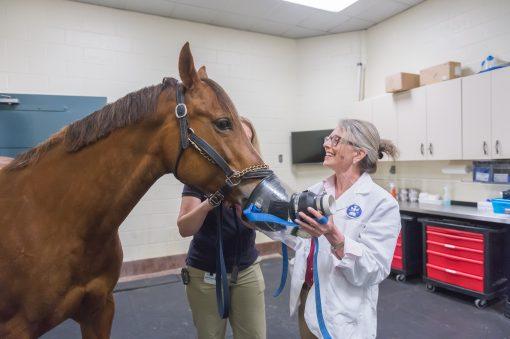-
About
- Leadership & Faculty
- News & Events
-
Academics
- Graduate
- Advanced Clinical Training
- Continuing Education
- Academic Departments
- Academic Offices
- Simulation Experiences
-
Student Life
- Offices
-
Research
-
Hospitals & Clinics
- Emergency Care
- Hospital Services
-
Community Outreach
- Volunteer
10 Facts About Recurrent Airway Obstruction in Horses
Horses that live in barns, as well as horses living outside that are exposed to high levels of pollens, molds or other particulates, have an increased risk of ...

Horses that live in barns, as well as horses living outside that are exposed to high levels of pollens, molds or other particulates, have an increased risk of developing a chronic and debilitating respiratory syndrome, often known as heaves, or recurrent airway obstruction (RAO). Falling under the umbrella of equine asthma, RAO is a performance-limiting, respiratory disease that affects horses with long-term exposure or excessive sensitivity to particulates. RAO must be distinguished from the less severe form of equine asthma, known as Inflammatory Airway Disease (IAD), which is much more common, because IAD is potentially curable. RAO, on the other hand, can often be effectively treated, but a cure is unlikely.
10 need-to-know facts about this complex disease
- The distinguishing sign of RAO as opposed to IAD is clearly recognizable episodes of respiratory difficulty – the horse appears to be heaving with the effort to breath. These episodes come and go until the horse is very severely affected.
- The most common signs of RAO are chronic cough, nasal discharge, exercise intolerance, and respiratory difficulty. Horses with RAO may be normal at rest if they are in a period of remission, but often have an increased respiratory rate and/or cough. Because of this, a “heave line” can frequently be seen along the bottom edge of the ribs, caused by enlarged abdominal muscles due to excess work of breathing.
- There are two different forms of RAO: the barn-associated type seen in regularly stalled horses, and summer pasture-associated recurrent airway obstruction (SPARAO). This is most commonly seen in horses that live on pasture and come in contact with high levels of multiple airborne mold spores throughout the year.
- The average age of horses at onset is 9-12 years. There is some emerging evidence that there does appear to be a genetic component in some populations.
- Winter tends to be the most common season for heightened symptoms of barn-associated RAO in the North, while the most intense signs of pasture-associated heaves happen in the spring and early winter in the North, and in summer and early fall in the South.
- The diagnosis of RAO is based on history, management conditions and clinical signs. Additional diagnostic tests to confirm and characterize the issue include bronchoalveolar lavage (BAL), lung function testing, and chest radiographs in selected cases. Upper airway endoscopy is often performed in conjunction with these tests to help rule out upper airway causes of chronic cough.
- Horses with barn-associated RAO should be kept on pasture when possible, with fresh grass as the source of roughage and supplemented with pelleted feed. Round hay bales are highly allergenic and should not be fed.
- Horses with pasture-associated RAO should not be stalled in the same building as an indoor arena. Additionally, hay should preferably be stored in a different structure, and dusty bedding should not be used—particularly straw. These horses should be maintained in a dust-free stable environment.
- Complete feeds may eliminate the need for dry roughage; however, hay cubes are an acceptable, low-allergen alternative source of roughage and may be preferred by horses. Roughage is an important component of nutrition for horses, and it gives them great enjoyment – which is important to the overall wellbeing of the horse. For this reason, we often recommend hay steaming, denge hay, or well-soaked hay. The best option for each case should be discussed with a veterinarian.
- RAO is a chronic disease that requires life-long management. While horses with mild to moderate equine asthma can be successfully managed with environmental and dietary changes alone, horses with moderate to severe RAO will usually need additional drug therapy. If modifications are not made, the damage may become permanent and the condition could progress further.
- Severe or long-lasting cases—often caused by the inability to remove horses from the source of the particulates and allergens—typically require bronchodilators to relax and enlarge the airways and corticosteroids to reduce the inflammatory reaction. These drugs must be prescribed by your veterinarian.
Tufts Equine Respiratory Health Lab offers the most advanced and effective diagnosis and treatment for your horse and is the only place in New England offering a complete respiratory workup for equine athletes of all levels.